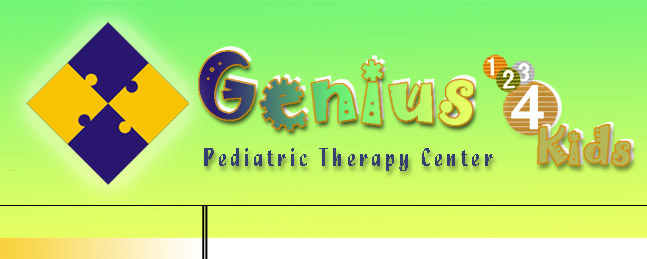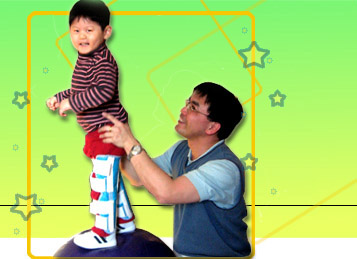|
密集運動訓練治療計畫
Intensive
Therapy Program- ITP
此密集運動訓練治療計畫是由訓練合格的認證治療師,結合專屬訓練器材-思若速特裝具
(TheraSuit®
Orthosis) 及全方位動態運動器
材(Universal
Exercise Unit)的操作技巧及運用運動的操作技巧及運用運動生理訓練的基本原則與概念,結合專屬訓練器材-全方位動態運
動器材(Universal
Exercise Unit),統合運用各種不同的治療手法及誘發技巧
(NDT,PNF,
TAMO, Pilates,...等),針對腦性麻痺或功能礙者的
個別需求,量身規劃的密集運動訓練治療計畫。在此個別化的密集運動訓練治療中,讓腦性麻痺兒童及有神經肌肉或運動功能障礙的個案
,藉由運用以上的專屬訓練器材,及統合運用各種不同的治療手法及誘發技巧,來減低病理運動模式、正常化肌肉張力及提供姿勢穩定性;
並在正常的本體感覺輸入的影響下,增強功能障礙患者的肌力及耐力、增強肌肉的控制與協調能力、增強功能性活動的能力、及發展適當
的平衡反應。藉以達到功能與活動技巧獨立自主及自理的最終目標。
(一).
訓練頻率:
每天
3-4 小時,每週五天,持續
3-4 週的密集運動訓練(依小孩或個案的個別情形及需求決定)。
(二).
訓練計畫內容:
*第一週:
減少肌肉張力及不正常運動模式,增加主動且正確的運動模式,並加強全身肌力。
*第二週:
加強訓練與功能性活動相關的個別或同功能性肌肉群。
*第三週:
學習運用已增強的肌力和耐力,改善功能性動作(坐、爬、行走、及跳躍等),以達功能及活動技巧獨立自主的個別
化功能訓練目標。
(三).
運動訓練計畫臨床效果:
-減低病理運動模式的影響
-增強肌力及耐力
-增強肌肉控制和協調
-增強功能性活動
(坐、爬、跪走、走等)
(四).
適用對象:
-腦性麻痺兒童
-發展遲緩患者
-中風患者
-創傷性腦損患者
-脊椎損傷患者
-神經肌肉及運動功能失調或障礙患者
*密集運動訓練治療法[TheraSuit
Method®]使用器材:
- 思若速特裝具-
TheraSuit®
- 全方位動器材-Universal
Exercise Unit (UEU)
- 上肢和下肢副木-
Arm & knee immobilizers
- 治療用球和椅-
Therapeutic Balls/ Benchs
- 熱敷包-
Hot pads
*密集運勳訓練課程選擇
-
| *
免費評估和咨詢服務 |
| *
運勳訓練課程
A |
每週五天,每天三小時,全期四週密集訓練。 |
USD
$7300 /每人每次訓練課程 |
| *
運勳訓練課程
B |
每週五天,每天三小時,全期三週密集訓練。 |
USD
$5500 /每人每次訓練課程 |
| *
運勳訓練課程
C |
每週五天,每天三小時,全期二週密集訓練。 |
USD
$3800 /每人每次訓練課程 |
聯絡我們
如何參加此運動計劃?
Typical
Intensive Therapy Program (ITP) Treatment Session :
*
Preparation Phase --
This
preparation period consists of warming up the muscles through
hot packs and massage followed by muscle stretching and strengthening
exercises so that they are ready for the second phase of
the therapy.
-
Moist
Hot-Packs - Apply 10 - 15 minutes of local heat to areas
of tight musculature.
-
Therapeutic
Massage - Apply 10 -15 minutes massage to prepare muscles
(warming up muscles and increasing local circulation)
for muscle stretching and strengthening exercises.
-
Muscle
Stretching and Range of Motion Exercises - 30-45 minutes
of muscle stretching, and combined with passive range
of motion exercises (PROM), active-assisted range of
motion (A-AROM), active range of (A-AROM), active range
of motion (AROM) and/or resisted range of motion (RROM)
to prepare for muscle strengthening and functional activities
training.
-
Muscle
Strengthening Exercises - Focus on weak single or muscle
groups, often utilizes the Universal Exercise Unit (UEU)
for muscle strengthening exercises.
-
Manual
Therapy - Consists of soft tissue and/or join mobilizations
to increase joint mobility or provide proper joint stability
and prepare the body for movement/exercise.
-
Sensory
Management - Consists of manual techniques, therapeutic
listening, and sensory integration program to provide
proper proprioceptive, auditory, and visual inputs to
promote engagement.
*
Second Phase --
During
the second phase of treatment sessions with applying combination
of TheraSuit® and floor activities, personally customized
activities which include proximal trunk stability training,
graded movement control in transitions, balance and coordination
training, and integrating all training skills into functional
activities such as head control, rolling, sitting up, crawling/creeping,
and walking training with assistive device or independence
are practiced.
-
Applying
TheraSuit® and TheraSuit Method® (if eligible
per physician) - Applying TheraSuit® and TheraSuit
Method® for muscle strengthening, balance and coordination
control training, gait pattern and functional activity
training. TheraSuit® also provides a more
ideal alignment in positions and proper proprioceptive
awareness during these activities.
-
Applying
Universal Exercise Unit (UEU) - It provides proper assistance
and resistance for weak single or muscle group
muscle strengthening, as well as improving muscle endurance,
enhances the single movement or the movement pattern
learning, and promotes, develops, and accelerates functional
skills learning.
-
Proximal
Trunk Stability and Graded Movement Control Training
- It promotes foundation of the stability before the
mobility.
-
Balance
and Coordination Training - These skills are essential
in order to maintain different postures as well as to
be able to move throughout different positions independently.
-
Functional
Activity Training - It includes activities such as head
control in different upright positions, rolling, sitting
up, crawling/creeping, kneeling, transfers, standing,
and walking training with assistive device or independence,
stair climbing, etc.
-
Gait
Training - With and without assistive devices.
*
Third Phase --
-
Home
Exercise Programs - In the third phase of the therapy,
home exercise programs and specific notices will be
instructed to consumers or their parents for further
enrichment of treatment. It contains detailed
written home exercise program booklet with pictures
and instruction, and video.
Enroll
my child
如何參加此運動計劃?
**Glossary
--
*Muscle
Stretching and Range of Motion Exercises -
Depends on the consumer's participation level and degree of
muscle tightness, muscle stretching exercise (the proper muscle
lengthening) is necessary to prevent the development of joint
contractures in a grow process, to promote more freedom of
movement, and to prevent loss of maintaining a proper posture
in standing upright or in ambulation.
*
Muscle Strengthening Exercises - Muscle
weakness is a major detriment to children with neuromuscular
disorders as it hinders the achievement of gross motor skills.
Muscle strengthening exercises can help the child to increase
control over how their body moves. For example, if a
child exhibits a scissor pattern when they are walking, by
way of muscle stretching and strengthening exercises to their
muscle group around hips, the child can display greater control
movement to step properly. Muscle strength training
coupling with muscle stretching exercise is the most effective
in treatment strategy.
*Balance
and Coordination - Balance includes the
ability to maintain positions, and to recover and react from
forces that might throw you off balance, as well as the ability
to safely fall, minimizing injuries. Coordination is
the ability to smoothly execute a movement through space.
These skills are essential in order to maintain different
positions as well as to be able to move through different
positions independently. Balance and coordination depend
on the interaction of multiple body organs and systems including
the eyes (visual system), ears (auditory system), spatial
orientation (vestibular system), brain and nervous system
(ability of motor learning and motor control, and motor processing),
cardiovascular system and musculoskeletal system. Balance
and coordination skills sometimes do not naturally occur in
children with neuro-musculoskeletal or neuro-motor disorders,
and they hinder their achievement of independent motor skills.
These skills can be taught repeatedly, and many children successfully
learn balance strategies after proper and correct instructions
and practices.
By
using TheraSuit® and TheraSuit Method®, and Universal
Exercise Unit (UEU) during Intensive Therapy Program treatment
session, the children can learn graded balance and coordination
control. Having good balance and coordination skills
can be the difference between needing assistance and being
able to complete a movement independently. It promotes
a better muscle strength, enhances the single movement or
the movement pattern learning, and promotes, develops, and
accelerates functional skills learning in proper correct postures.
*Functional
Activities - Intensive Therapy Program
focuses on functional activities training to promote and develop
independence of graded control in movements, transitions,
and functional skills. The children with neuro-motor
or neuro-musculoskeletal disorders will practice or perform
needed movements, transitions (side-sitting to quadruped position,
side-sitting to kneeling, kneeling to standing via a half-kneeling,
sitting to standing, and squatting to standing), or functional
skill in different developmental positions (sitting, crawling/creeping,
standing, walking, jumping, hopping, etc.) on their own after
muscle stretching and strengthening, and balance and coordination
enhancing training. Repetition is necessary to learn
new motor skills, and providing instruction of the "Home
Exercise Programs" to parents after treatment sessions
allows for this practice to take place. Moreover, each
child will receive an individually designed program to meet
his or her specific needs and to ensure the accommodation
of each child's goals.
*Gait
Training - Practicing
or performing walking or ambulation training can lead to final
goals of independence. The children with neuro-motor
or neuro-musculoskeletal disorders will practice and learn
the concept of weight bearing on the lower extremities in
standing and weight shifting from side to side or forward
and backward (as a pre-ambulation training) along with the
consequences in a safe way. We also uses a variety of
assistive devices depending on each individual child's abilities
and needs. This will enable children in all developmental
levels to gain exposure to walking skills.
Print
informaiton about
Intensive Therapy
Program (ITP)
Enroll
my child
如何參加此運動計劃?
|



